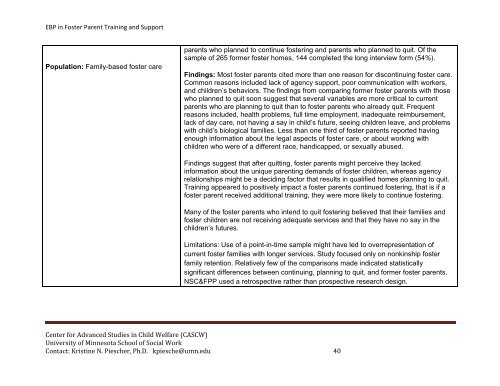Evidence-Based Practice in Foster Parent Training and Support ...
Evidence-Based Practice in Foster Parent Training and Support ...
Evidence-Based Practice in Foster Parent Training and Support ...
Create successful ePaper yourself
Turn your PDF publications into a flip-book with our unique Google optimized e-Paper software.
EBP <strong>in</strong> <strong>Foster</strong> <strong>Parent</strong> Tra<strong>in</strong><strong>in</strong>g <strong>and</strong> <strong>Support</strong>Population: Family-based foster careparents who planned to cont<strong>in</strong>ue foster<strong>in</strong>g <strong>and</strong> parents who planned to quit. Of thesample of 265 former foster homes, 144 completed the long <strong>in</strong>terview form (54%).F<strong>in</strong>d<strong>in</strong>gs: Most foster parents cited more than one reason for discont<strong>in</strong>u<strong>in</strong>g foster care.Common reasons <strong>in</strong>cluded lack of agency support, poor communication with workers,<strong>and</strong> children’s behaviors. The f<strong>in</strong>d<strong>in</strong>gs from compar<strong>in</strong>g former foster parents with thosewho planned to quit soon suggest that several variables are more critical to currentparents who are plann<strong>in</strong>g to quit than to foster parents who already quit. Frequentreasons <strong>in</strong>cluded, health problems, full time employment, <strong>in</strong>adequate reimbursement,lack of day care, not hav<strong>in</strong>g a say <strong>in</strong> child’s future, see<strong>in</strong>g children leave, <strong>and</strong> problemswith child’s biological families. Less than one third of foster parents reported hav<strong>in</strong>genough <strong>in</strong>formation about the legal aspects of foster care, or about work<strong>in</strong>g withchildren who were of a different race, h<strong>and</strong>icapped, or sexually abused.F<strong>in</strong>d<strong>in</strong>gs suggest that after quitt<strong>in</strong>g, foster parents might perceive they lacked<strong>in</strong>formation about the unique parent<strong>in</strong>g dem<strong>and</strong>s of foster children, whereas agencyrelationships might be a decid<strong>in</strong>g factor that results <strong>in</strong> qualified homes plann<strong>in</strong>g to quit.Tra<strong>in</strong><strong>in</strong>g appeared to positively impact a foster parents cont<strong>in</strong>ued foster<strong>in</strong>g, that is if afoster parent received additional tra<strong>in</strong><strong>in</strong>g, they were more likely to cont<strong>in</strong>ue foster<strong>in</strong>g.Many of the foster parents who <strong>in</strong>tend to quit foster<strong>in</strong>g believed that their families <strong>and</strong>foster children are not receiv<strong>in</strong>g adequate services <strong>and</strong> that they have no say <strong>in</strong> thechildren’s futures.Limitations: Use of a po<strong>in</strong>t-<strong>in</strong>-time sample might have led to overrepresentation ofcurrent foster families with longer services. Study focused only on nonk<strong>in</strong>ship fosterfamily retention. Relatively few of the comparisons made <strong>in</strong>dicated statisticallysignificant differences between cont<strong>in</strong>u<strong>in</strong>g, plann<strong>in</strong>g to quit, <strong>and</strong> former foster parents.NSC&FPP used a retrospective rather than prospective research design.Center for Advanced Studies <strong>in</strong> Child Welfare (CASCW)University of M<strong>in</strong>nesota School of Social WorkContact: Krist<strong>in</strong>e N. Piescher, Ph.D. kpiesche@umn.edu 40
















